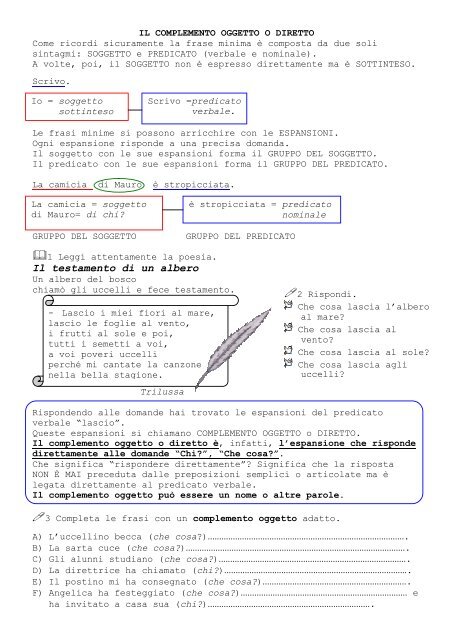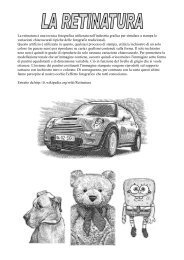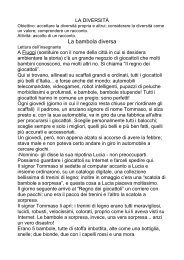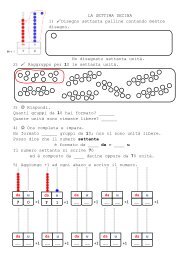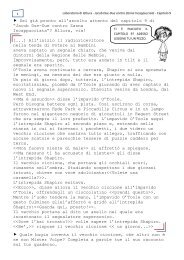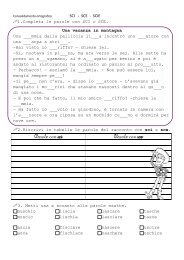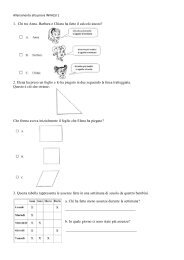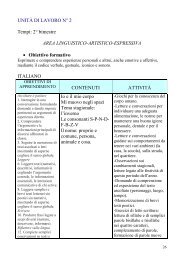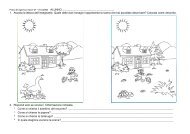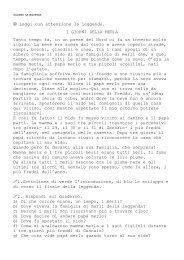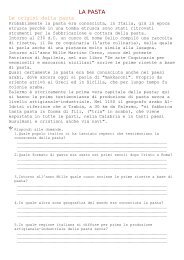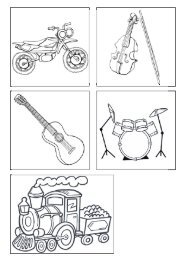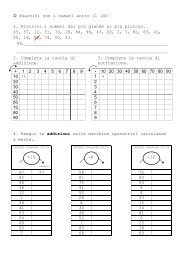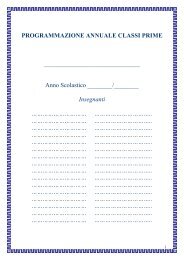Il testamento di un albero - Teca Didattica
Il testamento di un albero - Teca Didattica
Il testamento di un albero - Teca Didattica
Create successful ePaper yourself
Turn your PDF publications into a flip-book with our unique Google optimized e-Paper software.
IL COMPLEMENTO OGGETTO O DIRETTO<br />
Come ricor<strong>di</strong> sicuramente la frase minima è composta da due soli<br />
sintagmi: SOGGETTO e PREDICATO (verbale e nominale).<br />
A volte, poi, il SOGGETTO non è espresso <strong>di</strong>rettamente ma è SOTTINTESO.<br />
Scrivo.<br />
Io = soggetto<br />
sottinteso<br />
Le frasi minime si possono arricchire con le ESPANSIONI.<br />
Ogni espansione risponde a <strong>un</strong>a precisa domanda.<br />
<strong>Il</strong> soggetto con le sue espansioni forma il GRUPPO DEL SOGGETTO.<br />
<strong>Il</strong> pre<strong>di</strong>cato con le sue espansioni forma il GRUPPO DEL PREDICATO.<br />
La camicia <strong>di</strong> Mauro è stropicciata.<br />
La camicia = soggetto<br />
<strong>di</strong> Mauro= <strong>di</strong> chi?<br />
Scrivo =pre<strong>di</strong>cato<br />
verbale.<br />
GRUPPO DEL SOGGETTO GRUPPO DEL PREDICATO<br />
1 Leggi attentamente la poesia.<br />
<strong>Il</strong> <strong>testamento</strong> <strong>di</strong> <strong>un</strong> <strong>albero</strong><br />
Un <strong>albero</strong> del bosco<br />
chiamò gli uccelli e fece <strong>testamento</strong>.<br />
- Lascio i miei fiori al mare,<br />
lascio le foglie al vento,<br />
i frutti al sole e poi,<br />
tutti i semetti a voi,<br />
a voi poveri uccelli<br />
perché mi cantate la canzone<br />
nella bella stagione.<br />
Trilussa<br />
è stropicciata = pre<strong>di</strong>cato<br />
nominale<br />
Rispondendo alle domande hai trovato le espansioni del pre<strong>di</strong>cato<br />
verbale “lascio”.<br />
Queste espansioni si chiamano COMPLEMENTO OGGETTO o DIRETTO.<br />
<strong>Il</strong> complemento oggetto o <strong>di</strong>retto è, infatti, l’espansione che risponde<br />
<strong>di</strong>rettamente alle domande “Chi?”, “Che cosa?”.<br />
Che significa “rispondere <strong>di</strong>rettamente”? Significa che la risposta<br />
NON È MAI preceduta dalle preposizioni semplici o articolate ma è<br />
legata <strong>di</strong>rettamente al pre<strong>di</strong>cato verbale.<br />
<strong>Il</strong> complemento oggetto può essere <strong>un</strong> nome o altre parole.<br />
3 Completa le frasi con <strong>un</strong> complemento oggetto adatto.<br />
2 Rispon<strong>di</strong>.<br />
Che cosa lascia l’<strong>albero</strong><br />
al mare?<br />
Che cosa lascia al<br />
vento?<br />
Che cosa lascia al sole?<br />
Che cosa lascia agli<br />
uccelli?<br />
A) L’uccellino becca (che cosa?).......................................................................................<br />
B) La sarta cuce (che cosa?).................................................................................................<br />
C) Gli al<strong>un</strong>ni stu<strong>di</strong>ano (che cosa?)...................................................................................<br />
D) La <strong>di</strong>rettrice ha chiamato (chi?).................................................................................<br />
E) <strong>Il</strong> postino mi ha consegnato (che cosa?)................................................................<br />
F) Angelica ha festeggiato (che cosa?)......................................................................... e<br />
ha invitato a casa sua (chi?)........................................................................
4 Completa le frasi con <strong>un</strong> pre<strong>di</strong>cato verbale e <strong>un</strong> complemento<br />
oggetto.<br />
A) <strong>Il</strong> pittore (che cosa fa?/ha fatto?) .............................................................................<br />
(chi? che cosa?) ............................................................................................................................. .<br />
B) I giornalisti (che cosa fanno?/hanno fatto?) ........................................................<br />
(chi? che cosa?) ............................................................................................................................. .<br />
C) I miei amici (che cosa fanno?/hanno fatto?) ........................................................<br />
(chi? che cosa?) ............................................................................................................................. .<br />
D) Le api (che cosa fanno?/hanno fatto?) .....................................................................<br />
(chi? che cosa?) .............................................................................................................................. .<br />
E) I poliziotti (che cosa fanno?/hanno fatto?) ........................................................<br />
(chi? che cosa?) ............................................................................................................................. .<br />
5 Sottolinea <strong>di</strong> rosso il soggetto, <strong>di</strong> blu il pre<strong>di</strong>cato verbale e <strong>di</strong><br />
verde l’espansione COMPLEMENTO OGGETTO o DIRETTO.<br />
A) Ho letto <strong>un</strong> romanzo.<br />
B) <strong>Il</strong> Ministro ha promulgato <strong>un</strong>a legge.<br />
C) Gli studenti hanno deciso <strong>un</strong>o sciopero.<br />
D) Gli insegnanti organizzeranno <strong>un</strong>a protesta.<br />
E) Aprite il libro!<br />
F) Oggi farò la spesa con mamma.<br />
G) Tutti attendono l’arrivo della bella stagione.<br />
H) Silvia vorrebbe cantare.<br />
I) Ieri abbiamo eseguito le <strong>di</strong>visioni con i numeri decimali.<br />
J) La maestra ha appoggiato sulla cattedra il suo computer.<br />
6 Esegui l’analisi logica in struttura come nell’esempio.<br />
A) <strong>Il</strong> sole <strong>di</strong> marzo riscaldò il nido sull’<strong>albero</strong>.<br />
<strong>Il</strong> sole = soggetto<br />
<strong>di</strong> marzo = <strong>di</strong> che<br />
cosa?<br />
Riscaldò = pre<strong>di</strong>cato verbale<br />
il nido = che cosa? COMPLEMENTO<br />
OGGETTO<br />
sull’<strong>albero</strong> = dove?<br />
GRUPPO DEL SOGGETTO GRUPPO DEL PREDICATO<br />
B) Paul ha portato a scuola le figurine dei calciatori.<br />
C) Martedì Francesco ha <strong>di</strong>menticato a casa il flauto.<br />
D) <strong>Il</strong> free-climbing è <strong>di</strong>vertente.<br />
E) <strong>Il</strong> cavallino <strong>di</strong> Miriam ama galoppare nei prati.<br />
F) Domani correggerò i compiti dei miei al<strong>un</strong>ni.<br />
G) <strong>Il</strong> papà <strong>di</strong> Nicolò ieri al lago ha pescato due pesci.<br />
H) Marica è <strong>un</strong>a grande amica <strong>di</strong> Miriam.<br />
I) <strong>Il</strong> mese prossimo impareremo <strong>un</strong>a nuova melo<strong>di</strong>a per flauto.<br />
J) La civiltà degli Egizi è interessantissima.<br />
K) Non mi piace mangiare nella mensa della scuola.


